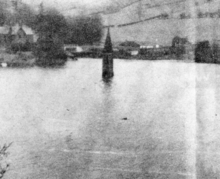Derwent, Derbyshire
| Derwent | ||
|---|---|---|
Shire county | ||
| Region | ||
| Country | England | |
| Sovereign state | United Kingdom | |
| Post town | HOPE VALLEY | |
| Postcode district | S33 | |
| Dialling code | 01433 | |
| Police | Derbyshire | |
| Fire | Derbyshire | |
| Ambulance | East Midlands | |
| UK Parliament | ||
Derwent was a village 'drowned' in 1944 when the Ladybower Reservoir in Derbyshire, England was created. The village of Ashopton, Derwent Woodlands church, and Derwent Hall were also 'drowned' in the construction of the reservoir.
Demolition

All buildings in the village had been demolished by autumn 1943, and the impounded waters of the reservoir began to rise by the end of 1944.
A 17th-century packhorse bridge in the village had a preservation order which prevented it from being demolished. In order to comply with this, the bridge was transported from the original location near Derwent Hall and reconstructed at the head of Howden Reservoir at Slippery Stones. It is now part of the footpaths and cycle tracks that run along the reservoirs.[1][2][3] The bridge is a scheduled monument, and it is one of the very few structures from Derwent village to have completely survived the reservoir's construction and still be visible.[4][5]
The church held its last service on 17 March 1943.
Remains

The site of the village has been revealed when the reservoir levels fell dramatically in 1976, 1989, 1995,[8] 2003, 2018[9] and 2022.[10]
In 2018, the appearance of the village due to low water levels caused unprecedented crowds to visit the rarely visible site. On 3 November 2018, a man had to be rescued by a mountain rescue team after getting stuck in extremely thick mud around the ruins of the village.[11] On 17 November 2018 it was reported that the site had been vandalised by some of those visiting, with park rangers forced to stop visitors removing items from the site and with graffiti scrawled on some buildings.[12]
Although nearly the whole village was flooded, a few houses survive above the waterline. One source notes that five houses from the old village remain, as well as the village hall and several farms.
The most significant surviving reminder of Derwent Village is the village's packhorse bridge, painted in 1925 by the artist Stanley Royle. The bridge was transported and rebuilt at the head of Howden Reservoir at Slippery Stones where it now forms part of the paths and cycle tracks around the Derwent Valley reservoirs.[14]
The Derwent Valley Museum, formerly
There is no formal memorial to any of the villages. However, the site of the temporary village at Birchinlee, built to house the construction workers for the higher Derwent and Howden Reservoirs, is marked by a plaque. The only marker of the location of Derwent is the village's War Memorial, which stands above Ladybower Reservoir at a point to the west of the village.[17]
Notable residents
- Charles Balguy was born at Derwent Hall in 1707.[18]
See also
- Listed buildings in Derwent, Derbyshire
- List of places in Derbyshire
- Capel Celyn (similar village 'drowned' to create a reservoir)
- Derwent Woodlands War Memorial
References
- ISBN 978-1-85058-392-9.
- ISBN 978-1-935-48749-4.
- ISBN 978-1-445-63191-2.
- ^ Historic England. "Reconstructed packhorse bridge from Derwent Hall See also DERBYSHIRE 18 (1003747)". National Heritage List for England. Retrieved 20 March 2021.
- ISBN 978-1-849-65545-3.
- ISBN 0-9505458-9-9.
- ^ "Old photos and postcards of Derwent Village in Derbyshire". Retrieved 20 April 2020.
- ^ "Long-lost photos of doomed Derbyshire villages that vanished". DerbyshireLive. 21 March 2022. Retrieved 16 August 2022.
- ^ Moat, Helen. "The lost villages of the Derwent Valley". www.bbc.com. Retrieved 16 August 2022.
- ^ "Ruins of 'lost church' exposed at Ladybower Reservoir". BBC News. 16 August 2022. Retrieved 16 August 2022.
- ^ "Low water levels reveal abandoned village". BBC News. 17 November 2018. Retrieved 25 November 2018.
- ^ "Rarely seen abandoned village vandalised". BBC News. 25 November 2018. Retrieved 25 November 2018.
- ^ "The Dambusters - 70 Years on". www.greatbritishlife.co.uk. 22 May 2013. Retrieved 5 September 2022.[title missing]
- ^ "Packhorse Bridge, Derwent, Derbyshire". Art UK. Retrieved 25 June 2016.
- ^ Dodds, Jonathan (13 January 2019). "Dambusters museum in the works for Derbyshire - here's where". Derby Telegraph. Retrieved 20 April 2020.
- ^ "Derwent Dam Museum". Derwent Dam Museum. 2012. Archived from the original on 2 July 2012. Retrieved 1 May 2014.
- ^ "Derwent Woodlands". www.warmemorialsonline.org.uk. War Memorials Trust. Retrieved 5 June 2013.
- doi:10.1093/ref:odnb/1200. (Subscription or UK public library membershiprequired.)
External links
- Peeping Tom statue moved from Derwent Hall to Castleton Hall YHA Archived 28 March 2013 at the Wayback Machine
